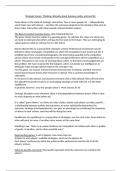Lecture notes
Complete IB3H9 Strategic Game Notes
- Institution
- The University Of Warwick (UoW)
This document contains all the notes from the synchronous and asynchronous lectures throughout the year and is split up lecture by lecture. This document on its own, is sufficient to get a top mark in your end of year exam for IB3H9 Strategic Games Notes.
[Show more]



